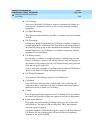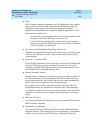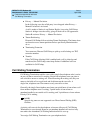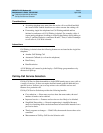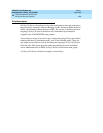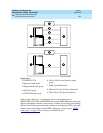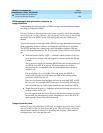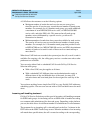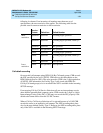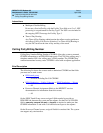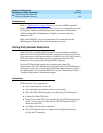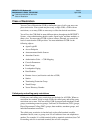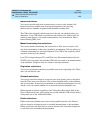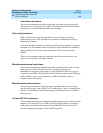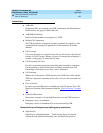
DEFINITY ECS Release 8.2
Administrator’s Guide
555-233-506
Issue 1
April 2000
Features and technical reference
1300Call-by-Call Service Selection
20
A UAP allows the customer to set the following options:
■ Maximum number of trunks that each service can use at any given
time.The sum for all services may exceed the total number of trunk-group
members. For example, for a15-member trunk group, you could administer
a maximum of seven MEGACOM service calls, six MEGACOM 800
service calls, and eight SDN calls. This ensures that all trunk-group
members are not dominated by a specific service, yet allows for
fluctuations in demand.
■ Minimum number of trunks that always must be available for each service.
The sum for all services may not exceed the total number of trunk-group
members. For example, for a 10-member trunk group that provides access
to MEGACOM service, MEGACOM 800 service, and SDN, the minimum
number of trunks to be used for each of these services cannot add up to
more than 10.
When these UAP limits are exceeded, the system rejects the call, even if a trunk is
available. On outgoing calls, the calling party receives a reorder tone unless other
preferences are available.
You can assign either fixed or scheduled UAP for each Call-by-Call Service
Selection trunk group.
■ With a fixed UAP, one plan applies at all times.
■ With a scheduled UAP, different plans can be administered to apply at
different times of day and different days of the week. As many as 6
activation times and associated plans can be assigned for each day of the
week.
You can have anything from a simple fixed UAP to a very flexible UAP with many
scheduling options. You can even start out with no UAP and build one as the need
arises.
Incoming call-handling treatment
Call-by-Call Service Selection provides special incoming call-handling treatment
for ISDN trunk groups. An incoming call on an ISDN trunk is handled according
to a treatment table administered for the trunk group. Depending on the platform
you use, the table allows for a different number of combinations of call treatments.
The treatment for an incoming call is selected based on the first 3 columns in the
ICHT table on the ISDN Trunk Group screen. When the attributes of an incoming
call match these specifications, the call is treated according to the corresponding



